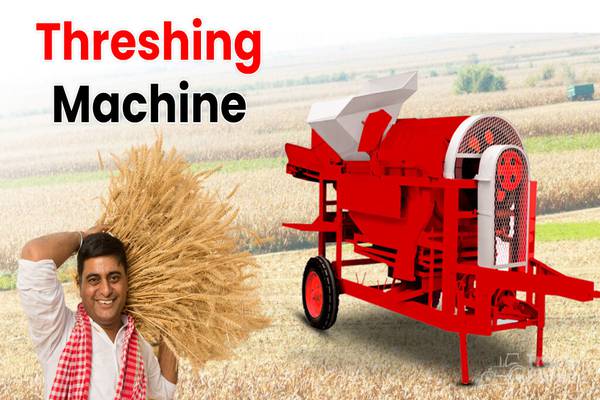Explore Threshing Equipment In Agriculture
Drafted by: vijaychourey26@gmail.com
Agriculture has been the backbone of human civilization since time immemorial. Over the years, advancements in agricultural technology have significantly improved the efficiency of various farming processes, including grain harvesting. One such innovation that revolutionized the way grains are harvested is the "Threshing Machine." In this article, we will delve into the world of threshing machines, exploring their evolution, working principles, advantages, challenges, and their crucial role in modern agriculture.
The Evolution of Threshing Machines
Throughout history, the process of separating grains from their stalks was a labor-intensive task done manually by farm laborers. However, with the Industrial Revolution, the need for increased efficiency in agriculture became apparent. This demand led to the development of the first threshing machines in the 18th century. These early machines were often horse-powered and operated using simple mechanical systems.
How Threshing Machines Work
The Basic Mechanism of Threshing
Threshing machines work on the principle of separating grains from their husks or stalks. The process involves beating the harvested crop to release the grains. The key components of a threshing machine are the thresher drum, concave, and straw walkers. As the crop passes through the machine, the thresher drum rotates, while the concave helps separate the grains from the rest of the plant material.
Types Of Threshing Machines
Cylinder Threshers: Ideal for small-scale farms, these machines use a rotating cylinder to thresh the grains.
Rotor Threshers: Employing a rotor mechanism, these machines are known for their high efficiency and versatility.
Axial-Flow Threshers: Utilizing a flow-through system, these machines are suitable for large-scale farming operations.
Spike-Tooth Threshers
Spike-tooth threshers have toothed cylinders that grab the crop and force it through concave teeth, separating the grains and straw.
Drum Threshers
Drum threshers use a rotating drum with small protrusions to separate the grains. They are well-suited for processing various types of crops, including cereals, legumes, and oilseeds.
Threshing Equipment And Crop Types
Cereal Crops
Threshing equipment is widely used for cereal crops like wheat, rice, barley, and oats. The machines can be adjusted to handle different grain sizes and moisture levels.
Leguminous Crops
Legumes such as peas, lentils, and soybeans require specialized threshing equipment due to their smaller size and delicate nature.
Oilseeds
Oilseeds like sunflower, canola, and sesame also require specific threshing methods to preserve the quality of the oil-rich seeds.
Factors Influencing Threshing Efficiency
Moisture Content
The moisture content of the crop plays a crucial role in the threshing process. Proper drying or conditioning is essential to achieve optimal results.
Threshing Speed
The speed of the thresher should be adjusted according to the crop type and conditions to prevent grain damage and minimize losses.
Concave Clearance
The gap between the rotor and the concave affects threshing efficiency. Adjusting this clearance optimizes the separation process.
Advantages Of Threshing Machines
Increased Efficiency and Productivity
One of the most significant advantages of using threshing machines is the tremendous increase in efficiency and productivity. Manual threshing is a time-consuming process that requires significant human effort. Threshing machines can handle large quantities of crops in a relatively short time, thereby significantly reducing the time and labor required for harvesting.
Labor-Saving Benefits
With the adoption of threshing machines, the burden on farm laborers has been significantly reduced. Farmers can now complete harvesting tasks quickly, allowing them to focus on other essential agricultural activities.
Reduction in Post-Harvest Losses
Threshing machines ensure a more thorough and controlled separation of grains, reducing the risk of grain loss during the harvesting process. This leads to higher yields and decreased post-harvest losses.
Challenges And Limitations
Initial Investment Costs
The acquisition of modern threshing machines can be a substantial initial investment for small-scale farmers. However, the long-term benefits of increased efficiency and reduced labor costs often outweigh the initial expenses.
Maintenance and Repairs
Like any machinery, threshing machines require regular maintenance to function optimally. Failure to conduct timely maintenance can lead to reduced performance and costly repairs.
Environmental Impact
The increased use of machinery in agriculture has raised concerns about its environmental impact. It is essential for farmers to strike a balance between productivity and sustainable practices to minimize any negative consequences.
Modern Innovations In Threshing Machines
ntegration of Technology
Threshing machines have evolved to incorporate advanced technologies such as GPS tracking, data analytics, and automation. These innovations enable farmers to optimize their harvesting operations and make data-driven decisions.
Automation and Smart Systems
Recent advancements have led to the development of automated threshing machines equipped with sensors and smart systems. These machines can adjust settings and optimize threshing based on real-time conditions, further enhancing efficiency.
Threshing Machines and Sustainable Agriculture
Impact on Sustainable Farming Practices
While the adoption of threshing machines offers numerous benefits, it is essential to consider their impact on sustainable farming practices. Responsible use of machinery, coupled with eco-friendly practices, can promote sustainable agriculture.
Promoting Food Security
Efficient grain harvesting using threshing machines plays a vital role in ensuring food security. With increased yields and reduced post-harvest losses, farmers can contribute to meeting the global demand for food.
The Future Of Threshing Machines
Potential Technological Advancements
As technology continues to advance, the future of threshing machines looks promising. More efficient and eco-friendly designs are likely to emerge, further revolutionizing the agricultural landscape.
Role in Global Agriculture
Threshing machines will continue to be indispensable tools for farmers worldwide. Their contribution to improving agricultural efficiency and productivity will be critical in meeting the challenges of a growing population and changing climate.








